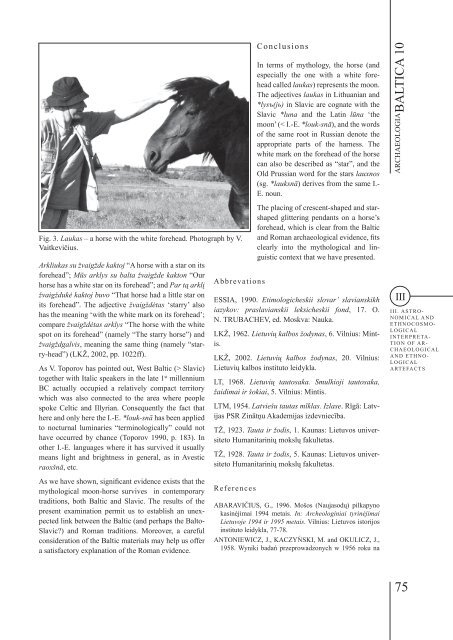BALTICA10
BALTICA10
BALTICA10
Create successful ePaper yourself
Turn your PDF publications into a flip-book with our unique Google optimized e-Paper software.
Fig. 3. Laukas – a horse with the white forehead. Photograph by V.<br />
Vaitkevičius.<br />
Arkliukas su žvaigžde kaktoj “A horse with a star on its<br />
forehead”; Mūs arklys su balta žvaigžde kakton “Our<br />
horse has a white star on its forehead”; and Par tą arklį<br />
žvaigždukė kaktoj buvo “That horse had a little star on<br />
its forehead”. The adjective žvaigždėtas ‘starry’ also<br />
has the meaning ‘with the white mark on its forehead’;<br />
compare žvaigždėtas arklys “The horse with the white<br />
spot on its forehead” (namely “The starry horse”) and<br />
žvaigždgalvis, meaning the same thing (namely “starry-head”)<br />
(LKŽ, 2002, pp. 1022ff).<br />
As V. Toporov has pointed out, West Baltic (> Slavic)<br />
together with Italic speakers in the late 1 st millennium<br />
BC actually occupied a relatively compact territory<br />
which was also connected to the area where people<br />
spoke Celtic and Illyrian. Consequently the fact that<br />
here and only here the I.-E. *louk-snā has been applied<br />
to nocturnal luminaries “terminologically” could not<br />
have occurred by chance (Toporov 1990, p. 183). In<br />
other I.-E. languages where it has survived it usually<br />
means light and brightness in general, as in Avestic<br />
raoxšnā, etc.<br />
As we have shown, significant evidence exists that the<br />
mythological moon-horse survives in contemporary<br />
traditions, both Baltic and Slavic. The results of the<br />
present examination permit us to establish an unexpected<br />
link between the Baltic (and perhaps the Balto-<br />
Slavic?) and Roman traditions. Moreover, a careful<br />
consideration of the Baltic materials may help us offer<br />
a satisfactory explanation of the Roman evidence.<br />
Abbrevations<br />
Conclusions<br />
In terms of mythology, the horse (and<br />
especially the one with a white forehead<br />
called laukas) represents the moon.<br />
The adjectives laukas in Lithuanian and<br />
*lysъ(jь) in Slavic are cognate with the<br />
Slavic *luna and the Latin lūna ‘the<br />
moon’ (< I.-E. *louk-snā), and the words<br />
of the same root in Russian denote the<br />
appropriate parts of the harness. The<br />
white mark on the forehead of the horse<br />
can also be described as “star”, and the<br />
Old Prussian word for the stars lauxnos<br />
(sg. *lauksnā) derives from the same I.-<br />
E. noun.<br />
The placing of crescent-shaped and starshaped<br />
glittering pendants on a horse’s<br />
forehead, which is clear from the Baltic<br />
and Roman archaeological evidence, fits<br />
clearly into the mythological and linguistic<br />
context that we have presented.<br />
ESSIA, 1990. Etimologicheskii slovar’ slavianskikh<br />
iazykov: praslavianskii leksicheskii fond, 17. О.<br />
N. ТRUBACHEV, ed. Moskva: Nauka.<br />
LKŽ, 1962. Lietuvių kalbos žodynas, 6. Vilnius: Mintis.<br />
LKŽ, 2002. Lietuvių kalbos žodynas, 20. Vilnius:<br />
Lietuvių kalbos instituto leidykla.<br />
LT, 1968. Lietuvių tautosaka. Smulkioji tautosaka,<br />
žaidimai ir šokiai, 5. Vilnius: Mintis.<br />
LTM, 1954. Latviešu tautas mīklas. Izlase. Rīgā: Latvijas<br />
PSR Zinātņu Akademijas izdevniecība.<br />
TŽ, 1923. Tauta ir žodis, 1. Kaunas: Lietuvos universiteto<br />
Humanitarinių mokslų fakultetas.<br />
TŽ, 1928. Tauta ir žodis, 5. Kaunas: Lietuvos universiteto<br />
Humanitarinių mokslų fakultetas.<br />
References<br />
ABARAVIČIUS, G., 1996. Mošos (Naujasodų) pilkapyno<br />
kasinėjimai 1994 metais. In: Archeologiniai tyrinėjimai<br />
Lietuvoje 1994 ir 1995 metais. Vilnius: Lietuvos istorijos<br />
instituto leidykla, 77-78.<br />
Antoniewicz, J., KACZYŃSKI, M. and OKULICZ, J.,<br />
1958. Wyniki badań przeprowadzonych w 1956 roku na<br />
ARCHAEOLOGIA BALTICA 10<br />
III<br />
III. ASTRO-<br />
NOMICAL AND<br />
ETHNOCOSMO-<br />
LOGICAL<br />
INTERPRETA-<br />
TION OF AR-<br />
CHAEOLOGICAL<br />
AND ETHNO-<br />
LOGICAL<br />
ARTEFACTS<br />
75
















